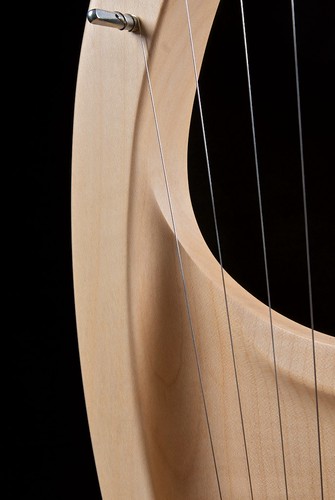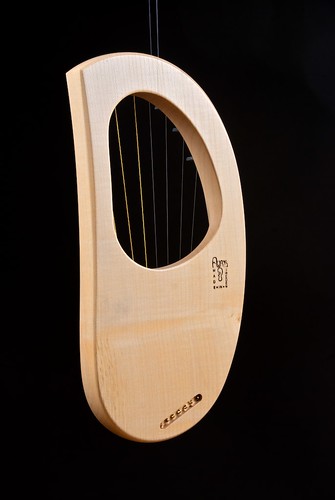
|

|

|

|
Listen to the LOP lyre:
LOP – Seven String Childrens Harp
Pitch Pipe
Lyre Stand
A=432Hz Tuning Fork
Replacement Strings
Seven tone Pentatonic lyre d’-e’-g’-a’-h’-d’’-e’’
A basic pentatonic lyre for introduction of music to the child. For use at home, in the kindergarten by musical games and storytelling and much more.
Special feature
While this model has an opening in the area where you play the strings, it is possible to use both hands simultaneously. To do this you put the lyre in an upright position on your lap resting on the left hand wrist, you can let it slide down slightly between your thighs to have a firmer grip. The two handed playing challenges and stimulates the motoric skills and balance.
Includes a tuning wrench and an instruction sheet that contains more tips and tricks regarding how to use your instrument.
THE PENTATONICAL SCALE
The Art Make Sense lyre is a seven stringed instrument tuned in a pentatonic scale. This scale spans over five whole tone steps and is built up by an open fifth tuning. The special thing about the pentatonic scale is that whatever you do with it, it will always sound good. You can let the fingers stroll up and down the strings in any combination of tones and it gives you little sweet melodies all the time. A light, almost heavenly scale that allows you to create music freely without the frustrating struggle with wrong notes or inharmonious sound. The experience of the five tone scale is fundamental in all music. You can find it in new and ancient folk music, classical pieces as well as in popular music. Children all over the world, spontaneously sings it in various ways. For this reason it is the adult's obvious companion in the work with children. From infancy up to the third grade, this scale meets the child's inner need.
THE LYRE
This instrument is meant to be a simple but powerful tool, with which, through games, playing together and listening, the child can learn music in its fullest meaning. The aim has been to create a lyre with a clear and light-filled sound, carried by the material's own tone quality. To achieve this, the strings are brought into balance with the static resistance of the shaped wood, which is needed so that the whole body of the lyre will be penetrated and resound with the tone's movement. In this living process, the "voice" of the instrument has its origin. ‘The Art Make Sense lyre is made out of maple wood.
HOW TO PLAY AND TO HOLD
The instrument is made to be held in the left hand (pict.1). The left hand grip gives the player freedom to dance and to move the lyre to the music. It also makes it possible to practise finger and chord playing. For two handed playing the lyre can be held on the lap (pic.2). If you want to have some rhythmical fun with the instrument, let a paper strip be woven through the strings, hold it in both hands and play it like an African thumb piano (pic. 4). To obtain a sharper sound you can even pluck the strings with a guitar pick.
STRIKING THE TONE
In order to obtain warm and full sound, a support-string technique is recommended. Hold the hands so that the fingers lay almost parallel to the strings (pict.1). Place the finger on the string to be played as shown in picture 3 and feel the "weight" of the warm and relaxed hand on the string. Make a light press-pull movement and then release the string. Let the finger land on the next higher "support-string" – do not pull it away from the lyre, it makes the tone harder. One can imagine oneself shooting with a miniature bow and arrow. Just as the archer waits until he has his target clearly in sight before releasing the string; so must the player of the lyre become "one" with the coming tone, inwardly preparing the let go of the string and then follow the rising and subsiding tone. A free and dynamic playing style can be attained through a careful practise of this basic technique. Quick runs and arpeggios will be possible to perform with the same warmth and fullness as single tones. Also chords can be played by using this same technique with several fingers at the simultaneously.
DRONE PLAYING.
Tune the lyre in to an open, minor or major chord. Let the chord run in the background while you sing or play melodies on top of it. With many lyres in a group you can create chord melodies by letting the children pass different drone chords on to one another. All can play in unison, in different key or in canon. If you swing the lyre while playing the sound will “grow". In spite of its simplicity, the instrument gives many possibilities in melody and chord playing, accompaniment to solo and choir singing and improvisation to an open chord. The musical games can be varied as long as your fantasy lasts.
DIFFERENT TUNINGS
The easiest way to obtain a well-tuned pentatonic scale is as follows: the middle string is tuned to a' with the help of a tuning fork or an instrument with a stable pitch. Then the lowest string is tuned to d', which is the interval of a fifth below a' and the highest string is tuned to e'' a fifth above a'. The octaves d'' and e' are then given. The two tones left g' and b' are tuned in fourths d' – g' and b' – e''. The tuning can be checked by playing the triads e'' – b' – g' (e minor), d'' – a' – e' (e sus 7) and b' – g'- d' (g major). When these harmonise, the lyre is well tuned. If it is difficult for you to recognize the intervals, the lyre can of course be tuned tone by tone with the help of another instrument, for example a piano or a flute. In time one comes to know the right tuning by ear. Each string can be tuned one and a half tone higher than its normal pitch. This gives a great freedom to experiment with different scales. Here are some examples in which we get acquainted with the music of various cultures. All these scales are not 100% genuine but are meant as an inspiration for your own attempts.
THE FIRST TUNING
In order for the lyre to hold its pitch as long as possible after tuning, it is important that the very first tuning is done correctly: First tune all of the strings to their right pitch. Then press down relatively hard with your finger in the middle of each string. It should flex 1/4 inch (7-8mm). The tones will now have become lower because the strings stretch and the lyre body bends slightly under the string tension. Now, repeat the procedure until the strings withstands the pressure of your finger without losing their pitch.
Please note: Never turn the tuning key without listening to the string at the same time!
CHANGING THE STRINGS
The strings are changed either when they no longer hold a clear tone or when they have broken. When you change a broken string you must not forget to unscrew the tuning pin as many turns as it has been tightened. This will be about three or three and a half turns. The tuning pins have left hand threads which means that they screw out clockwise, and in counter-clockwise. When the new string is placed on the lyre, it is attached to the pin as shown in picture A and wound up as in picture B.